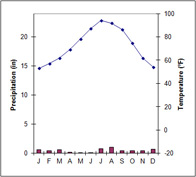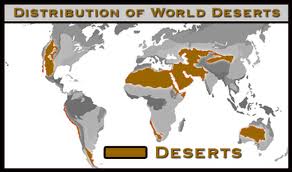Providing information pertaining to the Desert biome.
 ^ Climatogram of "warm deserts" Gila Bend, AZ Location of the Desert biome around the world. Generally between 20 and 30 degrees latitude. -> | ClimatogramsClimatograms are graphs that show abiotic factors in a biome. Examples of abiotic factors are precipitation levels, temperature, evaporation rates, humidity levels, wind, and radiant energy produced by the sun. The most important abiotic factors are temperature and precipitation levels. A climatogram graph has a double Y-axis that plots the average monthly temperature and precipitation levels.  |
Most deserts have an arid climate that receives and average of less than 10 inches a year. Desert biomes are defined as having very low levels of precipitation and a limited array of organisms that are adapted enough to survive in these climates. Arid desert biomes' temperatures may exceed 100 degrees Fahrenheit on summer afternoons, but may drop by 20 and 30 degrees at night. Winters are cool to cold: "Hot deserts" rarely ever experience frost, whereas "cold deserts" will experience extended periods of time of below freezing temperatures (Woodward).
Deserts can be found on the western portions of continents that are between 20 and 30 degrees latitude; this includes the Baja Desert in western California and the western Sahara desert in northern Africa.
Deserts are in the shadow of a high mountain range this occurs when air masses are pushed across a mountain range and the air heats up and evaporation exceeds any chance of precipitation, a commonly known example of this is Death Valley, CA.
The final location that deserts can be found are the interiors of continents. This is generally a combination of the rain shadow effect and being far from a large source of moist air, examples of this kind of desert include the Gobi desert, the Great Basin desert, and the Australian desert (Woodward).
- Arches National Park - Utah
- Death Valley National Park - South Eastern California
- Joshua Tree National Park - Southern California
- Lake Mead National Recreation Area (NRA) - Arizona
- Mojave National Preserve (The Mojave Road) - South Eastern California, Southern Nevada, North Western Arizona
- Saguaro National Park - South Eastern California and Arizona
- Organ Pipe Cactus National Monument- South Eastern California and Arizona
- Lake Havasu State Park - South Eastern California and Arizona
- Kartchner Caverns State Park - South Eastern California and Arizona
- Picacho Peak State Park - South Eastern California and Arizona
- Yumma Crossing SHP - South Eastern California and Arizona
- Yuma Territorial Prison SHP - South Eastern California and Arizona
- Arizona- Sonora Desert Museum - Arizona
- Great Basin National Park - Nevada
- High Desert Oregon and Idaho Border - Oregon and Idaho
- Big Bend National Park - Texas
- Big Bend Ranch State Park - Texas
- Carlsbad Caverns National Park - New Mexico
- Guadalupe Mountains National Park - Western Texas
Biotic Factors
Desert biomes are full of life and are overall extremely bio-diverse. Each organism has adapted and and evolved to be better suited for the harsh climate. Shrubs are the main type of vegetation due to being the best adapted of any other plant. Shrubs can be evergreen or deciduous, they generally have small leaves, and typically have some sort of natural protection (i.e. thorns, spines, etc.). Shrubs possess root systems that spread further than that of the shrub, increasing the amount of water that is absorbed during the occasional rains. This vast root system helps shrubs times of extreme drought. Another advantage that has made the shrub the ideal form of vegetation is that the ground between each individual shrub is bare, allowing the shrubs to make the most of the limited water supply in the arid climates.
Like the plants, many of the fauna (animals) have adapted accordingly. Most desert fauna spend the day in burrows and come out at dusk, night, or dawn when the desert is considerably cooler. Along with being mostly nocturnal, the fauna are well adapted to the limited rain fall as well. Reptiles are well adapted because they possess water-proof skin, hard shelled eggs, they produce uric acid instead of urine, and the high temperatures help regulate their body temperatures and if they get too hot they can go into their burrows. Other types of animal that are well adapted to the desert biome are birds. Why birds are so well adapted is because they aren't restricted to any one area, they can fly to an area of free water when needed. Their breeding seasons are like other temperate zone birds and are synchronized by changing photoperiods.